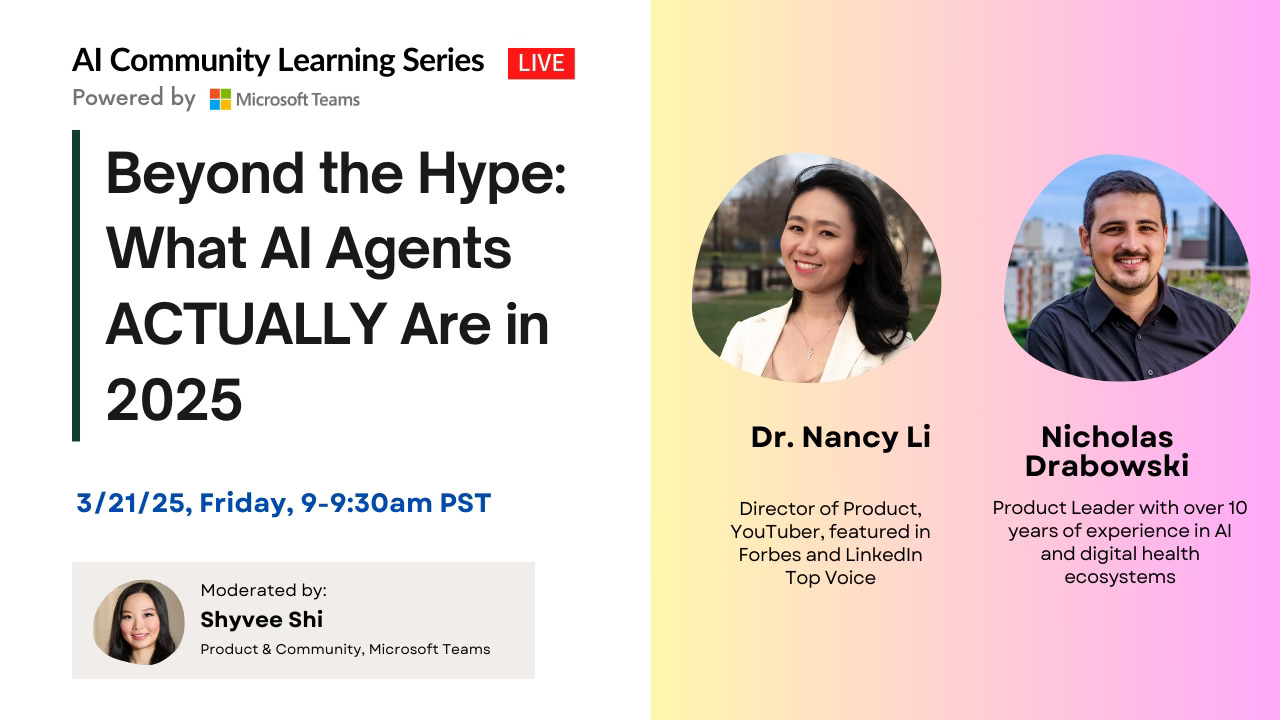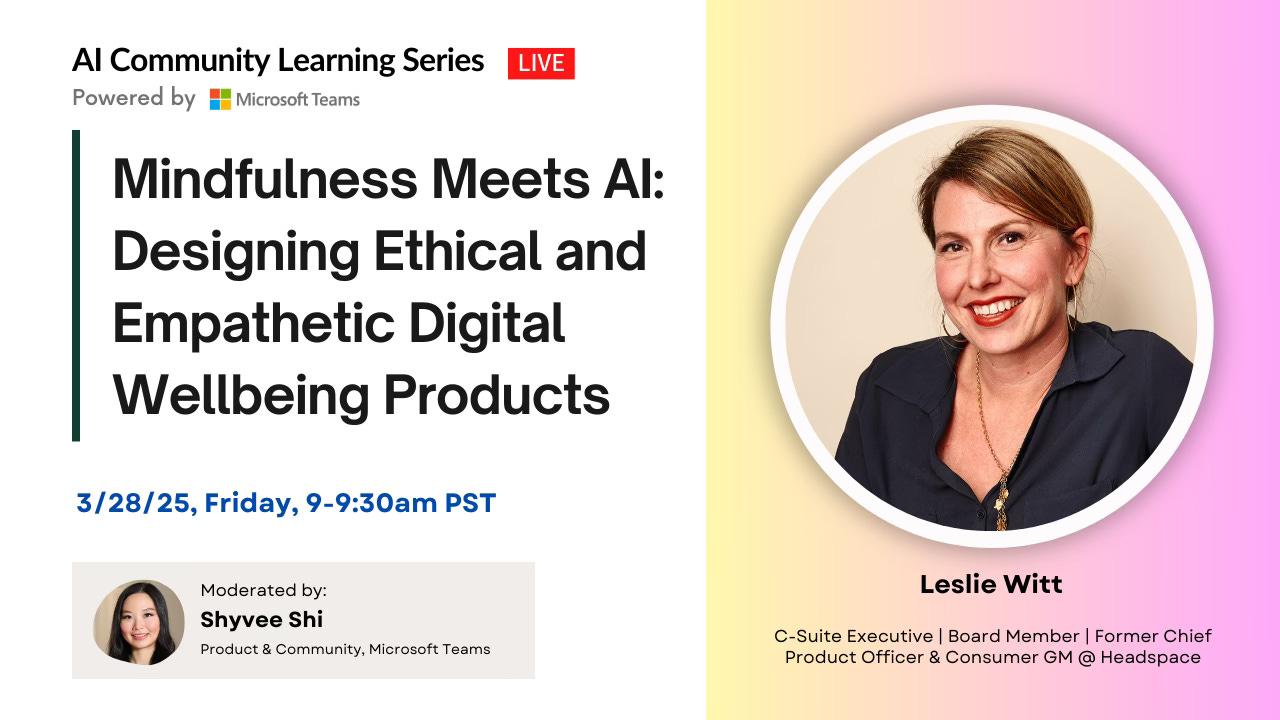Welcome to the latest issue of the AI Community Learning Series – a space to explore how leaders and innovators are reshaping industries with AI. In this session, Dr. Nancy Li and Nicholas Drabowski shared a behind-the-scenes look at what AI agents really are in 2025, cutting through the buzz to show how they work, what they can (and can’t) do, and how to build and assess them effectively. If you missed it, here are the highlights of our conversation and link to recording / hands-on demo.
What AI Agents Actually Are—Beyond the Buzz
"People expect superhuman quality from AI agents. But they’re average machines—built to mimic the average human response." — Nicholas Drabowski
It’s easy to get swept up in the hype around AI agents. But this session peeled back the layers to show what’s actually happening under the hood.
Dr. Nancy Li kicked things off with a candid clarification: not every chatbot or GPT prompt is an agent. A true AI agent engages in an iterative, feedback-driven process. It doesn’t just respond once—it plans, executes, evaluates, and adapts. Think of it more like a collaborator than a tool.
What’s even more critical? Knowing where we are on the roadmap to autonomy:
Basic Prompting is not an agent.
Agentic Workflows represent an evolving collaboration between human input and AI iteration.
Fully Autonomous Agents—à la Her—remain aspirational, though we're inching closer.
Live Demo: Watching Agents in Action
Nicholas brought it all to life with a real-time demo: building a webpage from scratch using a team of agents. Each had a defined role—researcher, developer, designer—executing in sequence to generate and iterate on a landing page for enterprise AI.
Key technical ingredients:
Framework Used: CrewAI (an open-source agentic orchestration tool).
Core Tasks: Planning content, coding in HTML, refining design, and debugging.
Under the Hood: Agents searched the internet, parsed results, and passed data between steps—autonomously adjusting their actions.
The result? A functional landing page—though, Nicholas noted, each run produced a different outcome. This unpredictability is part of the promise and the challenge of agentic systems: flexibility comes at the cost of consistency.
Lessons from Building Agentic Workflows
Throughout the conversation, Dr. Nancy and Nicholas emphasized real-world use cases and common pitfalls. Here's what stood out:
1. Agents ≠ Magic
Many organizations expect plug-and-play intelligence. The truth is that AI agents are only as good as the workflows, tools, and prompts you design. “It’s not a Super Bowl,” said Nicholas. “You still need to think deeply about structure, context, and reliability.”
2. Three Design Patterns You Need to Know
Dr. Nancy introduced the three dominant architectures:
Sequential Agents: Like an assembly line. Great for tasks with clear order (e.g., scan → extract → summarize).
Hierarchical Agents: One “manager” agent delegates to multiple sub-agents—perfect for complex coordination.
Parallel Agents: Multiple agents act simultaneously on different data streams (ideal for large-scale data processing).
3. Reliability Trade-Offs
Want flexibility? You lose consistency. Want deterministic results? You lose adaptability. Nicholas described this as the core agent paradox: the more generic and autonomous an agent becomes, the harder it is to control quality without careful design and validation layers.
Where Agents Are Already Thriving
Real-world examples are emerging across industries:
Healthcare: Over 90% of hospitals are leveraging AI agents for analytics and patient care.
Retail: AI-driven personalization is boosting revenue for 96% of top retailers.
Consumer Tech: Billions of voice assistants are now operating as lightweight agents.
Dr. Nancy Li’s own PM Accelerator: Building tools like AI interviewers and AI resume writers that rely on multi-agent coordination.
Takeaways for Builders & Leaders
Whether you’re an engineer or a PM, here’s what this session made clear:
Don’t confuse a fancy chatbot with a true agent.
Design your agent with structure and guardrails.
Expect variability—validate outputs.
Hands-on experience trumps theory.
You don’t need to be technical to get started—just curious and intentional.
Looking Ahead: What You Can Do Next
“In a few years, AI will be like AWS—just another API in your stack. But if you don’t build with it now, you’ll be left behind.” — Dr. Nancy Li
Start small. Build your own GPT. Tinker with tools like CrewAI. Or better yet, get hands-on with real-world projects through programs like the AI PM Bootcamp—where product managers team up with engineers to build functioning AI products used by real users.
The next cohort of AI PM bootcamp will start in Mid April. Members of this AI Enthusiast Community will get $700 discount (largest yet!) using promo code “SHYVEE”. You can learn more by attending Dr. Nancy Li’s FREE AI PM Workshop and start learning for free on her YouTube channel.
They are giving free access to AI PM Bootcamp to teenage kids from underserved communities through their nonprofit: PMA Kids. If you know someone who qualifies, please ask them to submit an application on our website.
And if you’re focused on purpose, not just productivity? Follow Nicholas’s lead: he’s currently leveraging agents at Save the Children to improve humanitarian program quality and impact around the world.
Upcoming Events
Fri, Mar 28, 2025, 9:00 AM - 9:30 AM
👉 Sign up





This insightful and very helpful, especially for a person with non-tech background like me.
Thank you